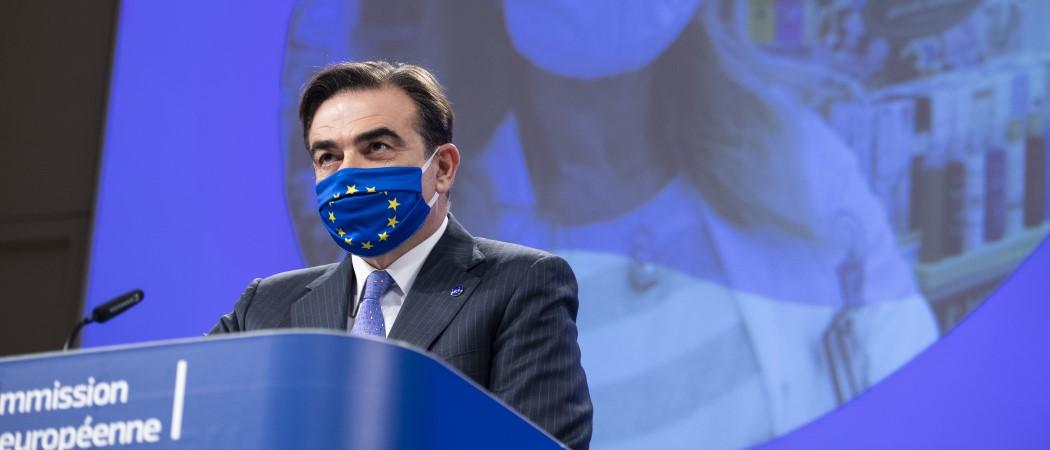Lessons of the pandemic loom large in EU’s pharmaceutical strategy. ‘Never again do we want to see the problems we faced in the first weeks of the crisis,’ says EU vice president Margaritis Schinas

Margaritis Schinas, Vice-President of the European Commission. Photo: European Commission.
The European Commission outlined its strategy for pharmaceuticals on Wednesday, with the goal of boosting drug development in Europe, making existing supplies more affordable and preventing the shortages seen in the first phase of the COVID-19 pandemic in March.
EU health commissioner Stella Kyriakides said “much more” is needed from politicians and companies to boost pharmaceutical production, develop new antibiotics and treatments for rare diseases, and ensure paediatric formulations are available for children.
“There’s nothing more devastating than the knowledge of facing a rare disease and there’s no medicine to turn to. Lives are lost because the market is failing,” said Kyriakides. Of an estimated 7,000 – 8,000 rare disease, there are approved therapies for only 5 per of them.
One strand of action will involve amending legislation to allow more innovative clinical trial designs.
Meanwhile, technologies like messenger RNA, used successfully by German biotech company BioNtech in its COVID-19 vaccine, can speed up manufacturing of biologic drugs by replacing cell-based production with synthetic production processes. Such “innovative trends can transform traditional development approaches, and reduce timelines,” the commission analysis says.
The strategy also promises to create market incentives for development of desperately needed antimicrobials, with infections caused by resistant bacteria causing over 33,000 deaths in Europe a year, according to EU data.
Lessons from COVID-19 loom large too, in a plan officials say will take four years to implement. “The pandemic has demonstrated that existing flaws in the health systems can have grave consequences in a crisis,” according to the analysis.
“The pandemic clearly showed us our limitations,” said Margaritis Schinas, the Commission’s vice president, presenting the strategy with Kyriakides.
“Never again do we want to see the problems we faced in the first weeks of the crisis,” said Schinas. “We found out that practically no one was manufacturing masks in Europe; we were facing export bans between our member states; and we discovered 80 per cent of active pharmaceutical ingredients were created outside the EU.”
Member states want the EU to draw up with a list of “essential medicines” and to ensure that the EU is not reliant on countries like India and China for supplies.
Many off-patent, generic drugs that are widely used, are produced at lower cost outside the EU . In other cases, shortages are the result of fragile supply chains, an insufficient number of suppliers, or the lack of commercial incentives to develop cheap and low-volume medicines.
Competition for access to limited drug supplies hurts patients in poorer countries, where the wait for certain treatments can be up to six times as long as it is in richer EU neighbouring states, according to a recent report by health research company IQVIA.
Officials say they will consult with the 27 EU governments and pharma officials on new commercial incentives for EU-based production.
One possibility is to target medicine shortage with tax breaks or procurement tweaks to entice manufacturers back to Europe, officials said. Whether there will be the money or political support to do these things however remains to be seen.
Before anything happens, the commission will carry out a study of global supply chains for drugs. “This is a very complex issue which requires the collection of additional data and further evaluation,” the EU analysis says.
The commission will also consider “targeted policies that support greater generic and biosimilar competition.” Possible actions are the removal of barriers that delay the entry of generics to market and clearer provisions for the conduct of trials on patented products to support biosimilar marketing authorisation applications.
A bigger market for generics is essential in bringing down the cost of medicines, said Kim van Sparrentak, a Green member of the European Parliament. "We have known for years now that the current system of market exclusivities for pharmaceutical companies does not lead to better health care, but to excessive prices of medicines,” she said.
Political winds
Industry reaction to the plan was largely favourable. The EU plan can help “stem the 25-year trend of cutting-edge science and investment leaving Europe for the US and China,” according to the industry group European Federation of Pharmaceutical Industries and Associations.
Claire Skentelbery, the new director general of Europe's largest biotech industry group, EuropaBio, said the strategy would “sharpen the EU’s competitive edge” and offer the “potential for the EU to reclaim its position as a leader in life sciences.”
EU commissioners are open about seeking more power in health policy, saying that the pandemic has overturned assumptions about everything.
“The political winds are very favourable,” said Schinas. “We are exploring every inch, every centimetre of our competences.” The Greek commissioner said the idea of the commission making advance purchase agreements for COVID-10 vaccines, as has happened in recent months, would never have been possible in normal times.
The EU plan wants to bring drugs production back home, but Schinas denied that it is about shielding European industry from foreign competition.
“We don’t see it as a backdoor to protectionism. We have 35 million jobs depending on exports,” Schinas said. The EU is the second largest market in the world, with total pharmaceutical spending around €190 billion in 2018.
Protectionist thinking harmed member states in the early phase of the pandemic, said Kyriakides. India, for example, curbed the export of paracetamol, which meant the painkiller disappeared from shelves in some EU countries.
“We need to understand the vulnerabilities of the supply chain [but] remain open to trade,” the EU health commissioner said. Another challenge that goes unexplored in the commission analysis is the likely increase in production costs if manufacturing relocates to Europe.
In other plans, the commission has called on member states to agree to wider mandates for both the European Centre for Disease Prevention and Control and the European Medicines Agency.
A new agency modelled on the US Biomedical Advanced Research and Development Authority is also in the works. Called the EU Health Emergency Response Authority, it will help EU officials anticipate future bio-threats and identify countermeasures.
“The European Health Union is not just a soundbite, it’s an emerging reality,” said Schinas.





 A unique international forum for public research organisations and companies to connect their external engagement with strategic interests around their R&D system.
A unique international forum for public research organisations and companies to connect their external engagement with strategic interests around their R&D system.